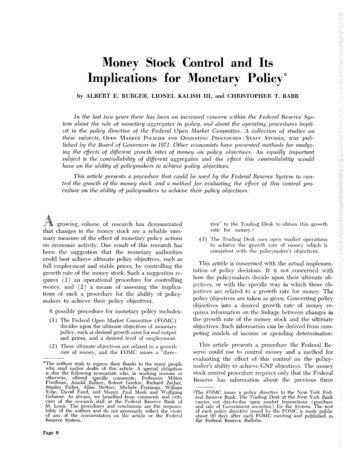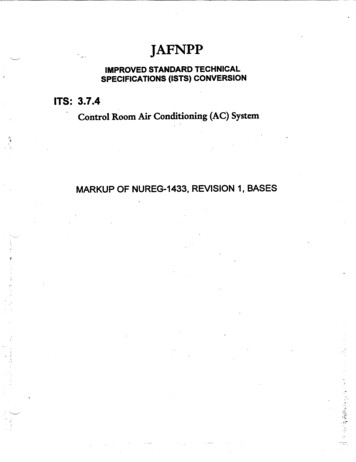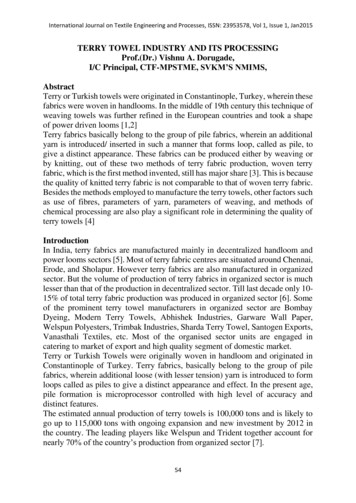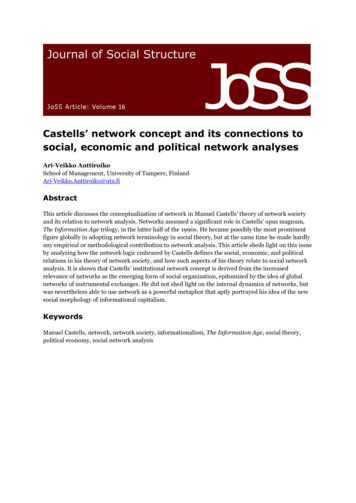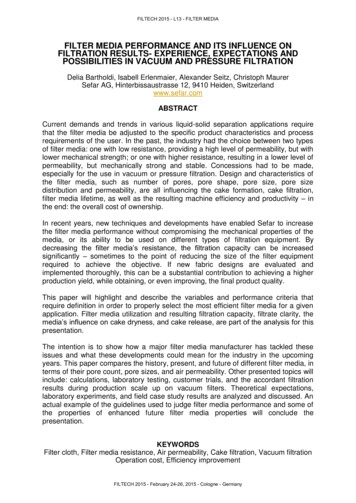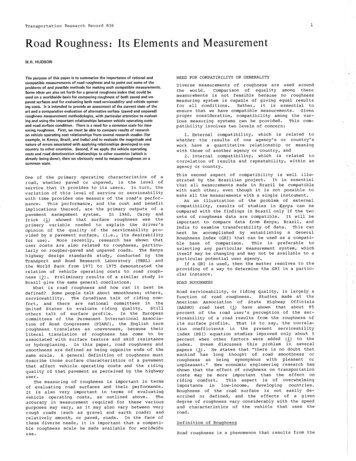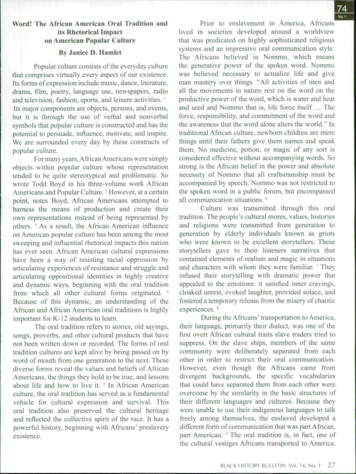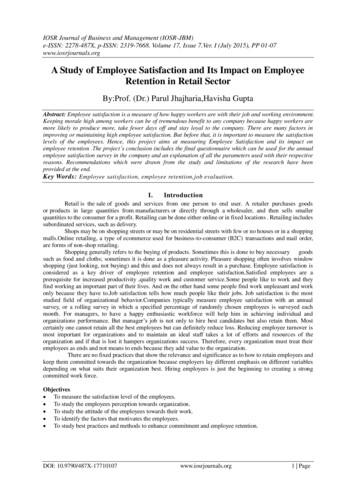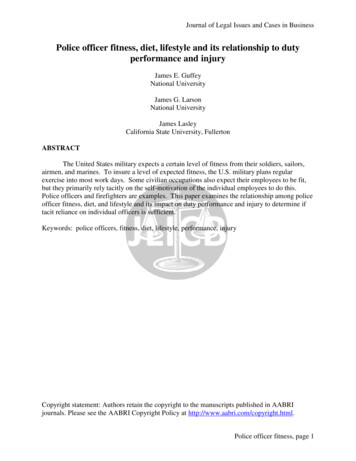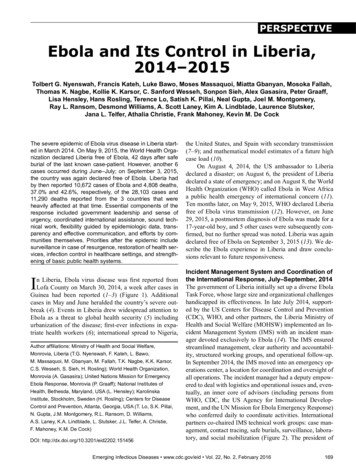
Transcription
PERSPECTIVEEbola and Its Control in Liberia,2014–2015Tolbert G. Nyenswah, Francis Kateh, Luke Bawo, Moses Massaquoi, Miatta Gbanyan, Mosoka Fallah,Thomas K. Nagbe, Kollie K. Karsor, C. Sanford Wesseh, Sonpon Sieh, Alex Gasasira, Peter Graaff,Lisa Hensley, Hans Rosling, Terence Lo, Satish K. Pillai, Neal Gupta, Joel M. Montgomery,Ray L. Ransom, Desmond Williams, A. Scott Laney, Kim A. Lindblade, Laurence Slutsker,Jana L. Telfer, Athalia Christie, Frank Mahoney, Kevin M. De CockThe severe epidemic of Ebola virus disease in Liberia started in March 2014. On May 9, 2015, the World Health Organization declared Liberia free of Ebola, 42 days after safeburial of the last known case-patient. However, another 6cases occurred during June–July; on September 3, 2015,the country was again declared free of Ebola. Liberia hadby then reported 10,672 cases of Ebola and 4,808 deaths,37.0% and 42.6%, respectively, of the 28,103 cases and11,290 deaths reported from the 3 countries that wereheavily affected at that time. Essential components of theresponse included government leadership and sense ofurgency, coordinated international assistance, sound technical work, flexibility guided by epidemiologic data, transparency and effective communication, and efforts by communities themselves. Priorities after the epidemic includesurveillance in case of resurgence, restoration of health services, infection control in healthcare settings, and strengthening of basic public health systems.In Liberia, Ebola virus disease was first reported fromLofa County on March 30, 2014, a week after cases inGuinea had been reported (1–3) (Figure 1). Additionalcases in May and June heralded the country’s severe outbreak (4). Events in Liberia drew widespread attention toEbola as a threat to global health security (5) includingurbanization of the disease; first-ever infections in expatriate health workers (6); international spread to Nigeria,Author affiliations: Ministry of Health and Social Welfare,Monrovia, Liberia (T.G. Nyenswah, F. Kateh, L. Bawo,M. Massaquoi, M. Gbanyan, M. Fallah, T.K. Nagbe, K.K. Karsor,C.S. Wesseh, S. Sieh, H. Rosling); World Health Organization,Monrovia (A. Gasasira); United Nations Mission for EmergencyEbola Response, Monrovia (P. Graaff); National Institutes ofHealth, Bethesda, Maryland, USA (L. Hensley); KarolinskaInstitute, Stockholm, Sweden (H. Rosling); Centers for DiseaseControl and Prevention, Atlanta, Georgia, USA (T. Lo, S.K. Pillai,N. Gupta, J.M. Montgomery, R.L. Ransom, D. Williams,A.S. Laney, K.A. Lindblade, L. Slutsker, J.L. Telfer, A. Christie,F. Mahoney, K.M. De Cock)DOI: http://dx.doi.org/10.3201/eid2202.151456the United States, and Spain with secondary transmission(7–9); and mathematical model estimates of a future highcase load (10).On August 4, 2014, the US ambassador to Liberiadeclared a disaster; on August 6, the president of Liberiadeclared a state of emergency; and on August 8, the WorldHealth Organization (WHO) called Ebola in West Africaa public health emergency of international concern (11).Ten months later, on May 9, 2015, WHO declared Liberiafree of Ebola virus transmission (12). However, on June29, 2015, a postmortem diagnosis of Ebola was made for a17-year-old boy, and 5 other cases were subsequently confirmed, but no further spread was noted. Liberia was againdeclared free of Ebola on September 3, 2015 (13). We describe the Ebola experience in Liberia and draw conclusions relevant to future responsiveness.Incident Management System and Coordination ofthe International Response, July–September, 2014The government of Liberia initially set up a diverse EbolaTask Force, whose large size and organizational challengeshandicapped its effectiveness. In late July 2014, supported by the US Centers for Disease Control and Prevention(CDC), WHO, and other partners, the Liberia Ministry ofHealth and Social Welfare (MOHSW) implemented an Incident Management System (IMS) with an incident manager devoted exclusively to Ebola (14). The IMS ensuredstreamlined management, clear authority and accountability, structured working groups, and operational follow-up.In September 2014, the IMS moved into an emergency operations center, a location for coordination and oversight ofall operations. The incident manager had a deputy empowered to deal with logistics and operational issues and, eventually, an inner core of advisors (including persons fromWHO, CDC, the US Agency for International Development, and the UN Mission for Ebola Emergency Response)who conferred daily to coordinate activities. Internationalpartners co-chaired IMS technical work groups: case management, contact tracing, safe burials, surveillance, laboratory, and social mobilization (Figure 2). The president ofEmerging Infectious Diseases www.cdc.gov/eid Vol. 22, No. 2, February 2016169
PERSPECTIVEFigure 1. Locations of Ebolacase-patients and associatedfacilities, Liberia, 2014–2015.ELWA, Eternal Love WinningAfrica; EOC, emergencyoperations center; ETU, Ebolatreatment unit; JFK, JohnFitzgerald Kennedy; MoD,Ministry of Defense.Liberia interacted directly with the incident manager. Separately, the president convened the Presidential AdvisoryCommittee on Ebola, a small group of senior officials andinternational partners who provided advice about sensitivematters and policy.Surveillance, Epidemiology, and LaboratoryDiagnosis, July 2014–May 2015An early priority for directing the response was surveillance. Using WHO case definitions for suspected, probable, and confirmed cases, the 15 counties of Liberiareported Ebola cases to MOHSW. Reporting modalities170included case investigation forms; mobile phone, text,and email messages; reports from Ebola Treatment Units(ETUs); laboratory results; and reports from burial teams,case investigators, and contact tracers. Timely reconciliation of data from multiple sources proved challenging.Constraints included shortage of trained staff, lack ofcommunication and information technology, poor internetand mobile phone coverage, and lack of transport fromremote locations.Choice of data management platforms proved difficult.Initially, case data were entered into an application basedon Epi Info version 7, developed by CDC for hemorrhagicEmerging Infectious Diseases www.cdc.gov/eid Vol. 22, No. 2, February 2016
Ebola and Its Control in Liberia, 2014–2015Figure 2. Organizationalflowchart for Ebola responseIncident Management System,Liberia Ministry of Health andSocial Welfare (MOHSW),August 2014. UNMIL, UnitedNations Mission in Liberia.Source: htmfever outbreaks (https://epiinfovhf.codeplex.com). However, in the face of a widespread epidemic, this software had limitations. In mid-December 2014, MOHSWchanged to District Health Information Software 2 (https://www.dhis2.org/), an open-source software platform enabling web-based data entry. Contact tracing generallydepended on paper and Excel (Microsoft, Redmond, WA,USA) spreadsheets maintained at the county level. Atthe national level, daily situation reports were compiledmanually from aggregate data received from the counties.Although these reports were instrumental in guiding theresponse, they were incomplete, contained duplicates, andcould not be analyzed in real time. Reconciliation of allavailable data is ongoing.In July 2014, only 1 laboratory, at the Liberia Institutefor Biomedical Research outside Monrovia, was able toconduct Ebola testing, with support from the US NationalInstitutes of Health and the US Army Medical ResearchInstitute of Infectious Diseases (5). International partners,including the US military, established a temporary laboratory network to provide Ebola test results within 24 hoursto anywhere in the country. By December 2014, real-timereverse transcription PCR testing for Ebola genomic RNAwas available at 10 laboratories nationwide. Throughoutthe outbreak, adequate staffing and rapid transport forspecimens, such as by helicopter from remote areas, remained challenging.Patient Isolation, Case Management, andEpidemic Trends, July–November 2014The IMS emphasized 4 pillars for interrupting Ebola transmission: 1) early detection, isolation, and treatment ofcases; 2) safe transport of patients with suspected cases; 3)safe burial; and 4) infection prevention and control (IPC)in healthcare settings. Isolating persons with Ebola was animmediate, overriding objective. Initially, contact tracingwas difficult because of the large number of cases and theurgent need to isolate patients and dispose of cadavers.By mid-July 2014, only 2 ETUs (20 beds each) wereoperational, in Foya (Lofa County) and Monrovia (Montserrado County). The principal organizations workingwith MOHSW to provide care for Ebola patients wereMédecins Sans Frontières (MSF) and Samaritan’s Purse,but Samaritan’s Purse withdrew after several of their staffmembers became infected with Ebola virus (6). By the endof July 2014, the country faced a crisis as the ETUs werefilled beyond capacity and Ebola patients were turnedaway, often dying on hospital grounds, in city streets, orin their homes. In mid-August 2014, MSF opened a tented120-bed ETU in Monrovia, the largest ever built, with capacity to expand to 400 beds (15). The rapid increase inEbola cases (5), extension of the epidemic to all counties,and projections from mathematical modeling (10) led theIMS to envision ETUs nationwide. Although a total of27 ETUs with 2,000 beds were planned, ultimately, 25Emerging Infectious Diseases www.cdc.gov/eid Vol. 22, No. 2, February 2016171
PERSPECTIVEwere built, of which 3 never opened and many remainedunderutilized as the epidemic waned.In early August 2014, intense discussions occurredwith MOHSW about the level of care that limited staffcould safely provide. Partners including MSF, CDC, andSamaritan’s Purse concluded that care should be simplifiedand that often only oral instead of intravenous rehydrationcould be safely provided (MSF and CDC, unpub. data; [5]).Partners also considered management in the community ifpatients were unwilling or unable to be evacuated. Lowerlevel community care centers (CCCs) were developed tomeet the urgent need for local isolation facilities before sufficient ETUs were constructed (15,16). However, capacityto build CCCs was also limited and impeded by concernfor inferior care or safety. Although 80 CCCs were envisaged, 10 became operational.The number of available ETU beds initially laggedbehind need, but by late September 2014, bed capacitiesexceeded new cases (Figure 3) (17). In retrospect, different data sources suggest that the incidence of diseasethat had started to increase exponentially in June peakedin early October 2014 and that during July–August, theepicenter shifted from Lofa County to Montserrado County (5,18). By November 2014, the epidemic was characterized by low numbers of cases overall, about half inMonrovia and the rest in small clusters in remote locations across the country, frequently initiated by infectedtravelers from the capital (19,20). Lower case counts andincreased staff facilitated data reconciliation. Manualmatching of laboratory results with ETU and burial databecame logistically feasible. Although incomplete, verified laboratory data proved the most useful indicator ofepidemic trends (Figure 4). Data from ETUs, although notcapturing all cases, provided descriptive characteristics ofpersons with Ebola.Management of Cadavers, July–December 2014The International Federation of Red Cross and Red Crescent Societies and the nongovernmental organizationGlobal Communities led safe collection and disposal ofcadavers, a culturally sensitive issue. Starting in September2014, initial efforts in Lofa and Montserrado Counties wereexpanded nationwide. Ebola testing of postmortem bloodor oral swab samples enabled detection of unrecognizedFigure 3. Trends over time for suspected, probable, and confirmed cases of Ebola virus disease from situation reports (sitreps); forconfirmed cases from laboratory reports (lab); and for numbers of Ebola treatment unit beds, Liberia 2014–2015. Ebola treatment unitbuild completion: A, Foya; B, Firestone; C, Eternal Love Winning Africa (ELWA) 1; D, ELWA2; F, ELWA3, John Fitzgerald KennedyHospital; H, Bong, Island; K, Unity; L, Ministry of Defense; M, Monrovia Medical Unit; N, Bomi, Kakata; O, China; P, Buchanan; SKD*;Q, Sinje, Ganta, Gbediah; R, Bopulu; S, Tappita, Zwedru; T, Voinjama; U, Zorzor, Greenville*; V, Barclayville; W, Fishtown*; X, Harper.*Other response events: E, Incident Management System implemented; G1–G2, burial teams trained and deployed. *Ebola treatmentunits built but never opened.172Emerging Infectious Diseases www.cdc.gov/eid Vol. 22, No. 2, February 2016
Ebola and Its Control in Liberia, 2014–2015collected by burial teams was estimated at 50%, even loweroutside of Montserrado County. An algorithm to use cadaverswab sample results to guide contact tracing was extensivelydiscussed but incompletely adopted (Figure 5).Figure 4. Epidemic curve for laboratory-confirmed cases of Ebolavirus disease, Liberia, April 2014–May 2015. Confirmed caseswere based on laboratory data per 21-day moving average.Ebola cases and assessment of excess deaths resulting fromEbola (21). In Monrovia, swampy topography and heavyrains in early August 2014 led to resurfacing of recentlyburied bodies, causing public outrage. The president of Liberia decreed mandatory cremation, a taboo that was accepted reluctantly and incompletely. The decree was liftedin late December 2014 when a public cemetery was openedoutside the capital.Ebola virus–positive cadavers in Montserrado Countypeaked at 380 during the week of September 15, 2014 (22).From October to December, the estimated proportion of Ebola virus–positive cadavers in Montserrado County declinedfrom 35% to 5%. However, the proportion of all bodiesEbola in Healthcare Workers and IPC,July 2014–May 2015Early investigations demonstrated great
depended on paper and Excel (Microsoft, Redmond, WA, USA) spreadsheets maintained at the county level. At the national level, daily situation reports were compiled manually from aggregate data received from the counties. Although these reports were instrumental in guiding the response, they were incomplete, contained duplicates, and could not be analyzed in real time. Reconciliation of all .
